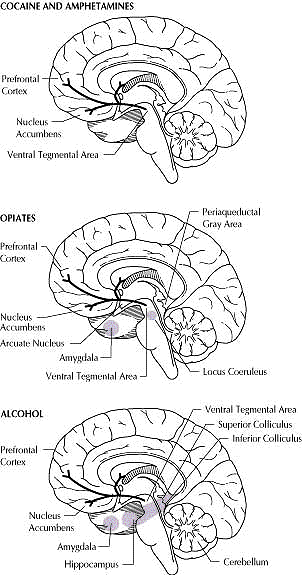
Scientists investigating which brain structures may be involved in the human drug reward system have learned a great deal from studies with rats. Because the chemistry of the human brain and the rat brain is similar, they believe that the process of drug addiction may be the same for both. The illustrations shown here use information gathered from animal studies to show what areas may be involved in reward systems in the human brain.
The cocaine and amphetamine reward system includes neurons using dopamine found in the ventral tegmental area (VTA). These neurons are connected to the nucleus accumbens and other areas such as the prefrontal cortex.
The opiate reward system also includes these structures. In addition, opiates affect structures that use brain chemicals that mimic the action of drugs such as heroin and morphine. This system includes the arcuate nucleus, amygdala, locus coeruleus, and the periaqueductal gray area.
The alcohol reward system also includes the VTA and nucleus accumbens and affects the structures that use GABA (gamma-aminobutyric acid) as a neurotransmitter. GABA is widely distributed in numerous areas of the brain, including the cortex, cerebellum, hippocampus, superior and inferior colliculi, amygdala, and nucleus accumbens.
The VTA and the nucleus accumbens are two structures involved in the reward system for all drugs, including alcohol and tobacco, although other mechanisms might be involved for specific drugs.
